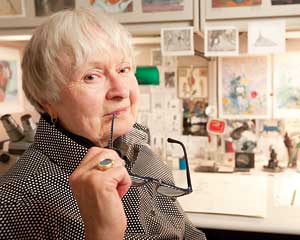From the dawn of science, artists have been creating finely detailed drawings of plants, first for healers seeking medicinal herbs and later for botanical and medical researchers.

The craft has survived for centuries. Even the invention of photography in the 19th century could not force obsolescence upon botanical illustrators. Through the centuries, fine details were best revealed by hand.
Although computer illustration programs improve by leaps and bounds and the number of illustrators has dwindled, longtime U-M Herbarium employee Karin Douthit continues to draw with her pencils and India ink-dipped steel pen.
“The intricacy — the way nature builds the plants, the wonderful things that you discover when you open up a plant and look at it: petals, the reproductive organs, the reticulation of the leaf and all these very minute details, makes you always wonder and be in awe about nature, actually,” Douthit says.
“As long as Bill (William R. Anderson, the Herbarium’s curator emeritus of vascular plants) gets his grants and as long as my hand is steady, I’ll work. It’s really fun and I really love it,” she says.
Anderson praises Douthit’s drawings. “They are often more beautiful than the real thing,” he says. “She can take an ugly little weed and turn it into a gorgeous piece of art, teaching us that even the humblest plant has its charms when shown in the best light by an artist of her talent.”
Authors Douthit has worked with have recognized her by naming a genus Karinia, and the species Amorimia kariniana and Byrsonima kariniana.

Born in Essen, Germany, in 1926, the former Karin Weishaar started drawing as a child. She studied at the Textil Ingenieur Schule in Krefeld and the Landeskunstschule in Hamburg before working as a textile designer in Paris in the 1950s. She met her husband, Harry, a nurse at a U.S. Army hospital and later a professor of microbiology, while working as a fabric designer in 1957.
After emigrating to the United States in 1959, the couple settled at the University of Texas in Austin, where she found her first work as a botanical illustrator. In 1967 the couple moved to Ann Arbor, and in 1969 she was asked by Rogers McVaugh to work for him on his publications at the former herbarium site near the School of Dentistry on Central Campus.
Today the Herbarium is in a light industrial park off Ellsworth Road. It is flanked by a thicket of trees, a buffer of sorts against the noise on nearby on I-94. Douthit, still active in her field after more than 40 years as an illustrator, works capturing the details of the plants of Mexico. In addition to her contributions to several U-M professors, her illustrations grace the publications of a number of other plant scientists from several universities. Currently she is drawing South American plants of the family Malpighiaceae. She is working with Anderson to create a reference book on this family of plants.
Seated, Douthit leans slightly over a counter to study the plant parts through a dissecting microscope. On the walls of her neat cubicle are prints by artists of all eras, from the Classical period to modern abstracts.
She draws freehand with a pencil then draws over pencil lines with pen and ink.
Of her favorite plants, Douthit says, “I think orchids are incredible. There are millions of species. It’s the way they adapt, what they do to fool insects and birds (to become pollinated); they attract spiders. They do so many different things with their petals. There’s one that looks exactly like a butterfly.”
After her son Tim recently suggested she explore other avenues of artistic expression, Douthit has been taking part in a life drawing class. “I do it for fun and relaxation,” she says. Douthit presents original artwork at her Web site www.kwd-art.com, but she hasn’t totally embraced new technology.
“I just hate computers. They give me the willies,” she says. “All this information you can find, I think that is interesting. But I’d much rather go to a book and do things by hand.”
She plans to continue working. “People say, ‘My god, can you do that forever?’ I say, ‘Yes. Plants are different. I love it all.”
The weekly Spotlight features staff members at the university. To nominate a candidate, please contact the Record staff at [email protected].

